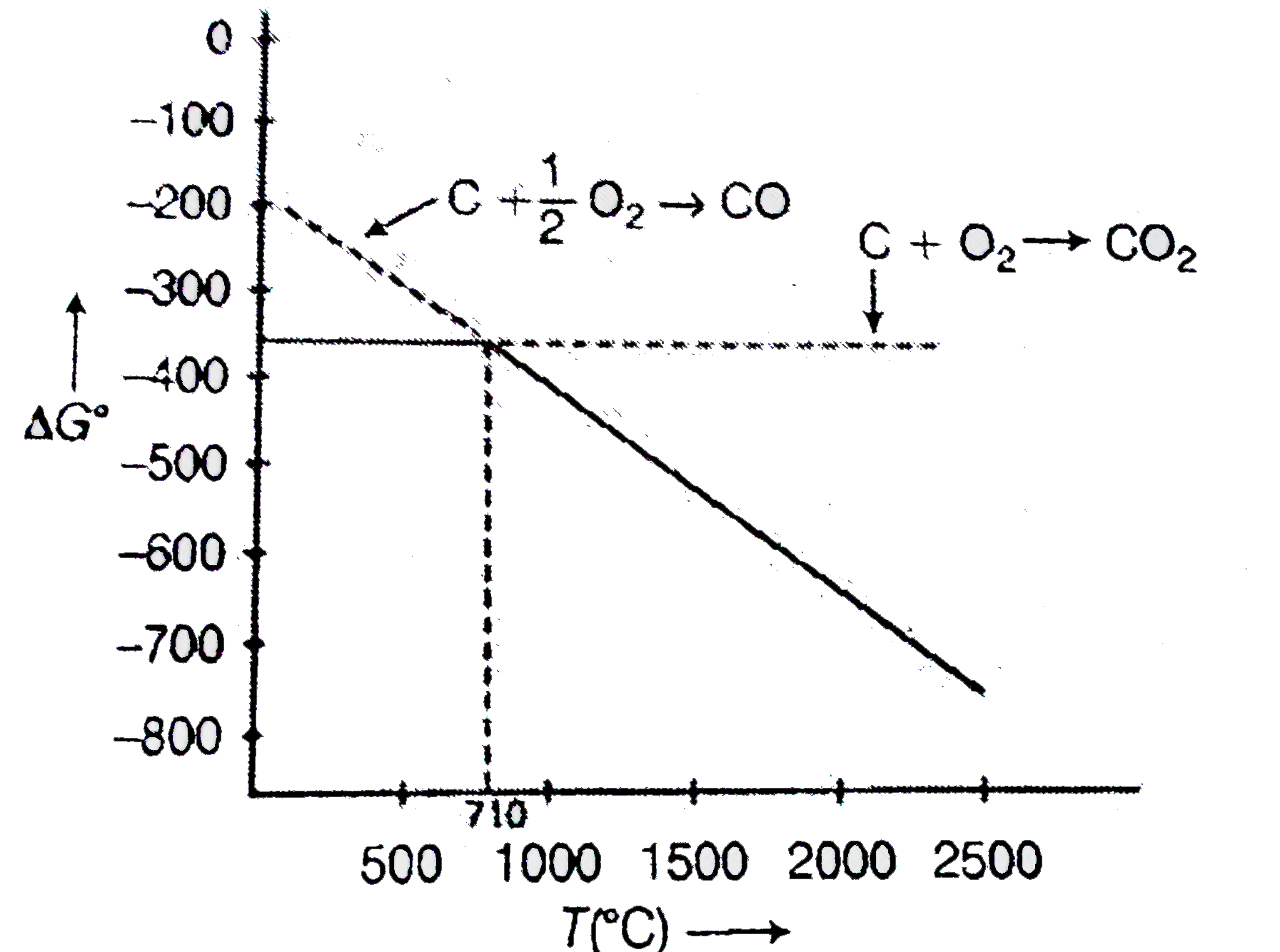Which of the following observations made from the Ellingham diagram is wrong ?
A
The slope of the curves of the formation of metal oxides is negative
B
Each curve is straight line except when some change takes place in phase (S−1or1→g)
C
In the case of less reactive (or less electroposities metal like AgandHg,ΔGӨ become positive at relatively low temperatures .
D
Any matel oxide with lower value of ΔGӨ is more stable than a metal oxide with higher ΔGӨ .
Video Solution
Text Solution
The correct Answer is:a
Consider the formation of a metel oxide (M2O)
2sM(s)+O2(g)→2M2O(s)
Is this reaction there is decreases in the value of ΔS ior M2O solid and O2 is a gas i.e. ΔS is negative .This if temperature is increases TΔS becomes . becomes more negative as is the equation
ΔG=ΔH−TΔSΔH is tengative formation of metal oxide is enothermic and TΔS (it negative quantity ) is substrcted ΔG becomes less negative i.e. ΔG is likely to increases with rise it in temperature and ythis trend is confirmed from the corves of metal oxide its Ellingham diagram .The slope of the curve of th e formation of metal oxides is −ve because ΔG becomes less negative or temperature with the rise in temperature
The temperature at which such a change occure is indicated by an incrfeases in the slope on the −ve side for example , in the Zn−ZnO "curve,the melting of Zn is incates by the first abropt increases in the-veslope at temperature692K.The indicates that both silver oxide (Ag,O) and merccury oxide (HgO) are unstate and decompose at relatively low temperature<br>2Ag_(2)O overset (Delta) To 4Ag + O_(2)<br>2HgO overset (Delta) To 2Hg + o_(2)<br>Thisamp≤stˆthemηl⊗placedhigher→thediagramcanbereductedbythemηl∈vcolved∈theformationofthe⊗placedlower∈thediagram.Forexamp≤byCt,<br> Ct_(2) O_(3) + Al rarr Al_(2)O_(3) + 2Ct<vbr>Thustherelactivetendencyofthevariousmηls→act∈reduc∈ga≥ntsis<br>Cu gt Mg gt Al gt Cr gt Zn gt Fe gt Ni
|
Updated on:21/07/2023
Related Playlists
- BOOK - R SHARMACHAPTER - GENERAL PRINCIPALS AND ISOLATION OF ELEMENTSEXERCISE - Flow up (Test - 5)6videos
GENERAL PRINCIPALS AND ISOLATION OF ELEMENTS
- BOOK - R SHARMACHAPTER - GENERAL PRINCIPALS AND ISOLATION OF ELEMENTSEXERCISE - Question bank33videos
GENERAL PRINCIPALS AND ISOLATION OF ELEMENTS
- BOOK - R SHARMACHAPTER - GENERAL PRINCIPALS AND ISOLATION OF ELEMENTSEXERCISE - Flow up (Test - 3)7videos
GENERAL PRINCIPALS AND ISOLATION OF ELEMENTS
- BOOK - R SHARMACHAPTER - ELECTROCHEMISTRYEXERCISE - Follow-up Test 117videos
ELECTROCHEMISTRY
- BOOK - R SHARMACHAPTER - NEET PREVIOUS PAPEREXERCISE - Solved Question51videos
NEET PREVIOUS PAPER
Knowledge Check
- Question 1 - Select One
Which of the following is not correct observation on Ellingham diagram ?
AA metal can reduce the oxide of other metal which lies above it in Ellingham diagram .BCO is more effective than C as a reducing agent below 710∘CCΔG∘ of metal oxides is higher than that of CO2 hence oxidation of metal suphides to oxides is not favourable.DNeed for conversion of metal sulphide to metal oxide before reduction can be explained thermodynamically. - Question 1 - Select One
Ellingham Diagram is useful
ATo know thetempreature where phase transformation ocuursBTo know the temperature where metal oxide decompose on its ownCTo select suitable reducing agent for reduction of metal oxideDAll of the above - Question 1 - Select One
Ellingham Diagram is useful
ATo know thetempreature where phase transformation ocuursBTo know the temperature where metal oxide decompose on its ownCTo select suitable reducing agent for reduction of metal oxideDAll of the above - Question 1 - Select One
Ellingham diagram represents :
Achange of △G with temperatureBchange of △H with temperatrueCchange of △G with pressureDchange of (△G−T△S) with temperature - Question 1 - Select One
Ellingham diagram represents:
Achange of ΔG with temperatureBchange of ΔH with temperatureCchange of ΔG with pressureDchange of (ΔG−TΔS) with temperature - Question 1 - Select One
Ellingham diagram respresents:
Achange of ΔG with temperature.Bchange of ΔH with temperature.Cchange of ΔG with pressure.Dchange of (ΔG−TΔS) with temperature. - Question 1 - Select One
Consider the following Ellingham diagram for carbon

Which of the following statements is incorrect for the above Ellingham diagramAUpto 710∘C, the reaction of formation of CO2 is energetically more favourable but above 710∘C, the formation of CO is preferredBCarbon can be used to reduce any metal oxide at a sufficiently high temperatureCCarbon reduces many oxides at elevated temperature because ΔG∘ vs temperature line has a negative slopeDΔS∘[C(s)+12O2(g)→CO(g)]
<ΔS∘[C(s)+O2(g)→CO(g)] - Question 1 - Select One
ELLINGHAM DIAGRAM
AΔG increases with an increase in temperature.BIt consists of plots of ΔfG∘Vs T for formation of oxides.CA coupling reaction can be well expressed by this diagramDIt express the kinetics of the reduction process.

